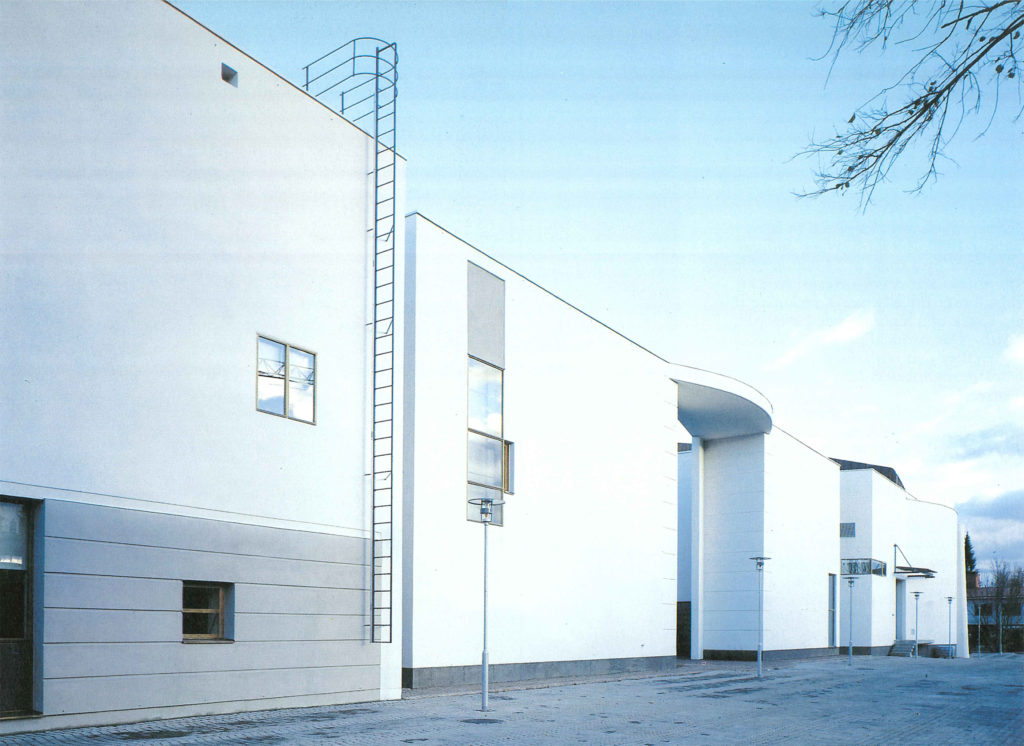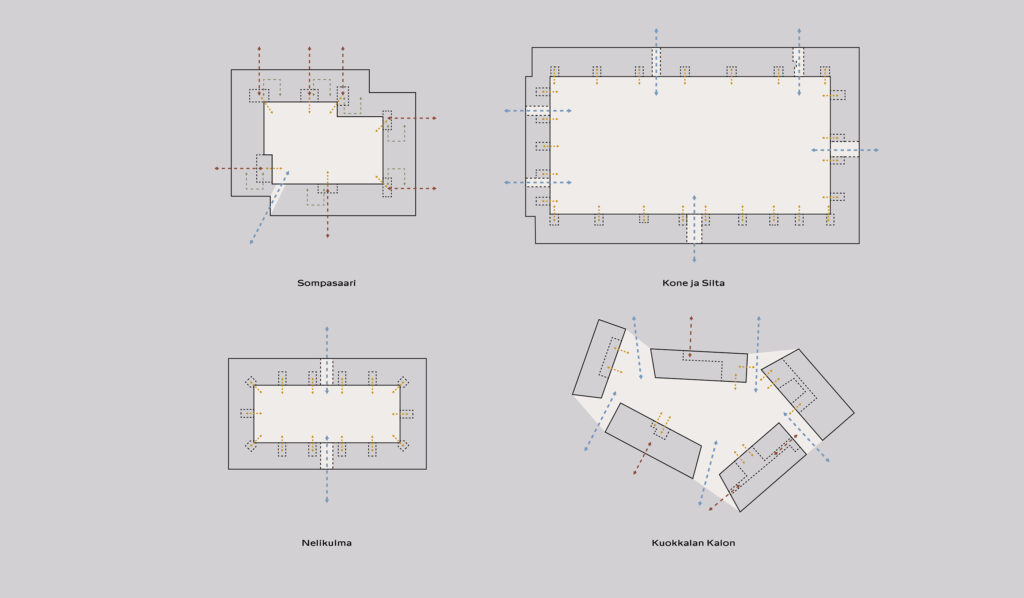Messages from the Past

Spurred on by the climate crisis, the philosophy of circular economy is changing the aesthetics of architecture. With more and more old building components being recovered and reused, we also need new concepts and methods.
“At times, it is the improbabilities that give rise to the most fascinating stuff. It is unlikely that architect Teemu Kurkela would ever have thought of designing a hexagonal column. It just happened to be forwarded to him from the 1980s.” This is what Henna Helander, President of the Finnish Association of Architects (Safa), tweeted in October 2021 when sharing the news of the Fyyri Library in Kirkkonummi winning the Finlandia Prize for Architecture. Designed by JKMM Architects, the regular shape of the new extension completed in 2020 completely envelops the original 1982 library building by Ola Hansson. The resulting, evocative whole is a work of contemporary architecture but also a circular economy project that upcycles the old building on site by adding a new layer to the structure.
Usually, the aim with upcycled structures is to camouflage them beyond recognition with new surface structures. The old surfaces in Fyyri have also been covered with new ones, thereby merging them as part of the new design. However, the preconditions dictated by the old part of the building introduce an element of surprise, particularly when it comes to the spatiality and essential layout of Fyyri. The concept of upcycling, a loan from the field of circular economy, is used by Anni Vartola in her project review, published in the Finnish Architectural Review, when referring to the chronological layers of Fyyri.Where the more traditional recycling refers to the utilisation of recovered materials in making new materials, upcycling entails the utilisation of a highly processed product or building component as it is.This allows the work, energy and design embedded in the product, as well as the historical and cultural “messages” entailed within, to be transposed into parts of the new whole. Especially in cases where the architectural solutions manifest a contrast between the old and the new, this type of transposition may be referred to with a concept of spolia, derived from the history of architecture. There just might be use for such an apt concept that recognises the aesthetic significance of repurposed components in contemporary architecture as well.1
A Play of Meanings
When left exposed, the aesthetics and history of upcycled parts and components, with all of their previous meanings, are preserved to be re-experienced. Recovered building elements and components allow the creation of architectural contrasts and layers, particularly when originating from a building whose purpose or period and method of construction differ completely from the new use and location. Upcycled parts present the contemporary architect with a toolkit packed full of the creative input of architects and manufacturers from different eras. As if by chance, the new building is gifted with historical depth, the patina of mature age and, possibly, also local character, if parts of a building that used to stand in the same area are utilised in the new project. At the same time, the new architecture may be infused with an air of craftsmanship, a higher quality of materials and solutions that veer off the path of current standards. Repurposed parts may open up quite unique horizons for contemporary architecture.
Due to the messages entailed in recovered parts, upcycled architecture is positioned within the field of eclecticism. 20th-century rationalists were quick to associate historical or period motifs and building components of varying ages with poor taste on the designer’s end and with a lack of resources that modern society would soon rid humanity of. Coming into the current decade, however, in the cross-pressure of global environmental challenges, it is only reasonable to ask whether we could redefine rationality. The understanding of the progression of climate change and the loss of biodiversity introduces new, compelling arguments for the recycling of raw materials. In fact, reinterpreted rationalism quite naturally steers us towards new types of design. The ideals of rationalism entail that the structural principles be easily discernible from the finished building. This means that reused and upcycled parts should also be set apart from the whole.
The task of selecting recovered components would introduce a new moving part onto the designing architect’s desk. The selection process could become smoother, however, if the parts were pre-provided, so to speak, from an existing building on the site or one that is to be torn down close by. The utilisation of the components close to where the material is generated or recovered minimises transport needs and is, therefore, resource-smarter.

The Ethics and Aesthetics of Upcycling
There are some special questions related to materials recovered from buildings of high cultural-historical value that are interesting to examine, even though they only constitute a marginal proportion of the overall material flows in society.
“In an ideal situation, there would be nothing left over from a heritage building because everything should be repaired”, says architect Robin Landsdorff from the Finnish Heritage Agency. “A building component should not be replaced until it is beyond repair, at which point it is no longer of any use anywhere else.”
From the perspective of a valuable building that yields building components, the situation is unequivocally paradoxical: the building inevitably loses some of its values and meanings with the parts and materials that it is bleeding out. Still, building components that are valuable in terms of cultural history are released not only from demolition sites but also in connection with large renovation and conversion projects.
Landsdorff brings up the example of the current trend in church renovations where original, fixed pews are being removed from worship halls to make room for a more versatile use of the spaces. In such situations, according to Landsdorff, the Finnish Heritage Agency almost always requires that “the pews are preserved in conditions similar to those of the church so that they can be brought back if the situation again changes.”
In practice, the principle of returnability is only applied to a small group of special buildings, and even in such buildings, the requirement is only applicable to components like fixed furniture and doors that can easily be stored and returned to the building. So, even in cases where the building yielding components is interesting in terms of cultural history and architecture, parts removed in connection with renovations are frequently sold at auction or dumped directly on a skip. As regards the building serving as a source of components, therefore, the issue of circular economy is a problematic one, but materials recovered from special buildings may bring the kind of high-profile visibility for the circular economy that will improve the preconditions for a circular economy in the construction industry and promote its further development.
The components dismantled from heritage buildings are often particularly well made, in addition to which an awareness of history is emphasised to an exceptional degree. When knowledge of the history of a building component actually increases the value of the component, the need to reiterate the message becomes stronger. We should therefore consider how information concerning the history of a building component could be recorded and communicated to the person experiencing the new architectural whole. It would be important to outline principles for how to link complementary written material to an element transposed from one building to another.
A closer look at the context of valuable buildings also reveals risks related to the development of the recovery and recycling system. The upcycling of building components with heritage value must not be made to appear too tempting an option in comparison to the conservation or renovation of the original building. In addition to contemplating architectural aesthetics based on technological systems and a circular economy, then, we need to discuss the ethical conditions for the upcycling of building components.

9Konstas Papatheodorou: Church of Agia Fotini Mantineias, Tripoli, Greece 1978. / 10, 11jo taillieu architecten: Paddenbroek Education Centre, Gooik, Belgium 2020. Photos: Filip Dujardin/ 12Wang Shu / Amateur Architecture Studio: Ningbo Historic Museum, China 2008. Photo: Siyuwj / 13 Church of St. Peter, Kalyvia Thorikou, Greece 12th–13th century. Photo: C. Messier / 14 Georg Grotenfelt: Sauna Huitukka, Juva 1982. Photo: Georg Grotenfelt / 15 David Chipperfield Architects: Neues Museum, Berlin 2009. Photo: Ute Zscharnt
Technical Challenges
A key special feature of recovered parts is their limited availability. The rarer the components we are talking about, the more evident this issue becomes. It is not possible to manufacture more historical, unique building components, and even the newer, serial-production parts do not become available at a pace tailored to accommodate the designer’s wishes, but rather in time with the cycles of renovation and demolition projects. The unsteady supply is a challenge for the designer and the development of the field. On the other hand, such restrictions could also be viewed as the premise of design, fuelling the designer’s creativity.
Many stumbling blocks remain on the path to the upcycling of building components. One of the biggest is the lack of collected data on the availability of the components and the lack of intermediate storage. The use of recovered parts is also made difficult by the fact that the Finnish construction industry is so heavily regulated and builders are used to utilising standardised components. To enable a steadier supply and to make the supply of redundant building components meet the demand, we need intermediate storage facilities and pre-established delivery chains. In order for the utilisation of recycled parts to become mainstream practice and more versatile, building regulations must also accommodate the possibility of recycling and upcycling better than they do currently. There is a demand in our country for a national spare parts bank – or, at the very least, a coordinating system set up to collect information.
The adoption of a circular economy calls for the redefinition of the relationship between contemporary architecture and renovation. Henna Helander stated recently in her editorial of Safa’s Arkkitehtiuutiset newsletter that what we need to establish is “the art of renovation”. Architecture based on a circular economy is, indeed, an opportunity to broaden and modify the actions we take to comply with sustainable development. Above all, the utilisation of upcycled parts allows us to conserve natural resources and achieve a more diverse, historically rich built environment. ↙
IIDA KALAKOSKI
Architect, university instructor and researcher specialised in the management of built heritage, who thinks that the climate crisis and expanding knowledge on the architectural heritage challenge us to examine the concepts of preservation and renovation anew.
RIINA SIRÉN
Architect and building conservator. Sees simple construction methods as an imperative for diverse built environments.
1 Kalakoski, Iida & Huuhka, Satu: “Spolia Revisited and Extended. The Potential for Contemporary Architecture”. Journal of Material Culture 23(2) 2018, 187–213.




